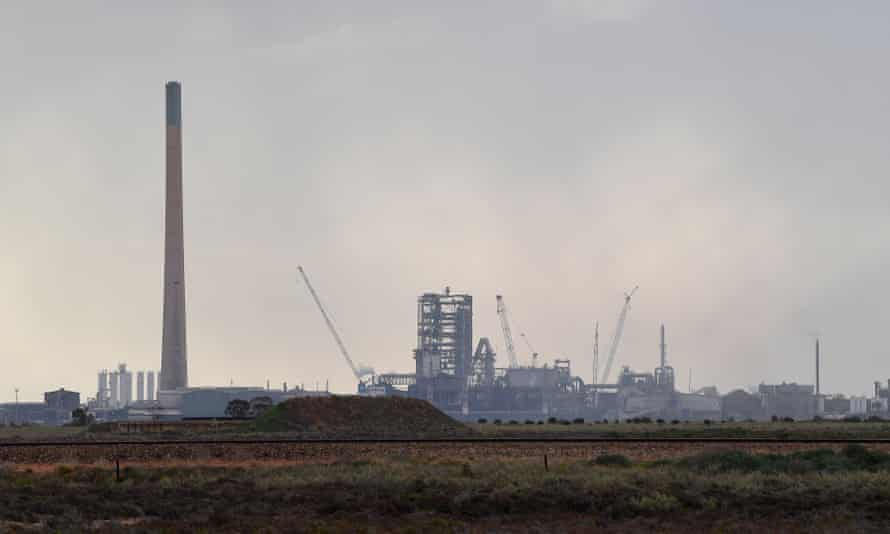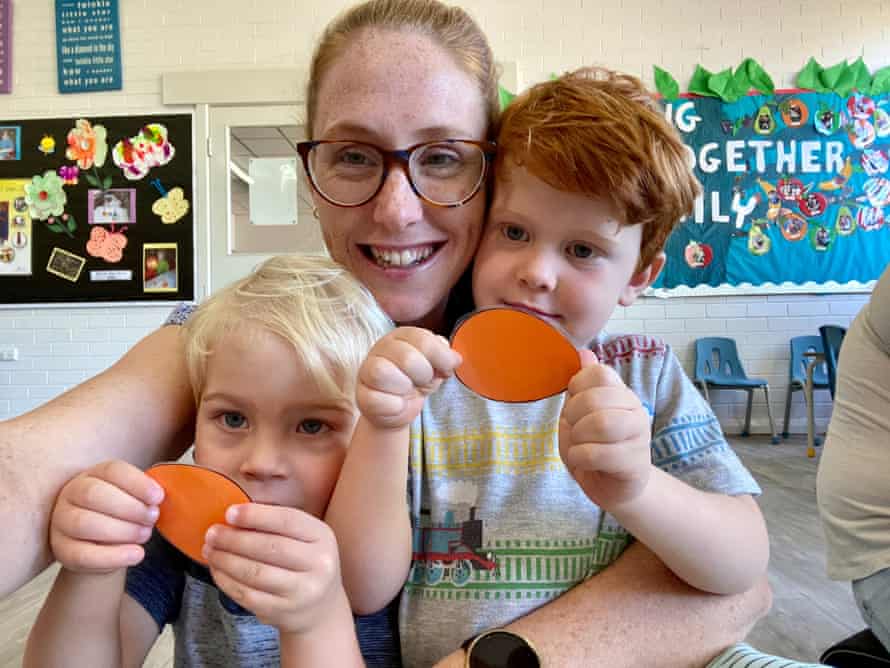In the shadow of Port Pirie’s lead smelter, parents fight a losing battle against contamination
Protecting children from the hazards of lead means a never-ending struggle against exposure to dirt, dust and even rainwater

Parents in Port Pirie are warned to “make sure baby’s cot is placed away from the window”, that the air conditioner is clean and the windows and doors are properly sealed. They should avoid rainwater, constantly clean toys and clothes, and try not to push prams into the wind, to avoid the ubiquitous lead in the town.
The Port Pirie lead smelter, which sits around 200km from Adelaide on the Spencer Gulf, has been running for more than a century. During that time the emissions have been building up in the blood of the local residents.
High blood lead levels can cause miscarriages in women. Children are more susceptible to the effects of lead than adults, and even relatively low levels can cause problems including “reduced growth, learning difficulties, behavioural problems and reduced IQ”.
National Health and Medical Research Council guidelines say blood lead levels should be less than five micrograms per decilitre. SA Health, the World Health Organization and the US Environmental Protection Agency, among others, say there is no safe level.
The latest SA Health report, released on 30 August, shows that in the first half of this year the average blood lead levels of Port Pirie children under five was 5.7 micrograms. For children tested on their second birthday it was 7.8 micrograms, the highest reading in a decade.
SA Health spokesperson Dr David Simon says the latest results show “a deterioration in all reported blood lead indicators compared to the same reporting period last year”.
“We do not want to see this increase in blood lead levels become a continuing trend, and the latest results highlight the importance of the smelter’s ongoing efforts to reduce its lead emissions.”

Nyrstar, which owns the smelter, has been working to cut emissions. It has been somewhat successful, although it has previously exceeded limits set for it by SA’s environmental protection agency. New technology put in with help from the state government has been plagued with issues.
The company says lead levels in the air have reduced, but that there is a lag before this reduction is seen in children’s blood levels.
SA Health and the Targeted Lead Abatement Program it runs with Nyrstar offer a range of advice and guidelines for Port Pirie parents.
Eat a healthy diet – but don’t touch the rainwater – to reduce the amount of lead being passed on to an unborn baby. Frequently wash toys, clothes, prams, and so on.
“When doing a dirty or potentially lead hazardous job, do not cuddle a baby until you have showered, washed your hair and changed your clothes,” SA Health says. Pets can be hazardous, as are clothes dried on an outdoor clothesline.
Port Pirie residents are warned to be careful of eating local fish or homegrown vegetables.
Mark Taylor, an honorary professor at Macquarie University, has spent years studying the relationship between lead emissions and blood lead levels. He says it’s clear that lead causes “permanent and real harm in children”, and that in Port Pirie it’s not just in the air, but in the soil, and that no one is taking ownership of the issue.
“Mums and dads can’t keep up with cleaning their homes of lead and contaminated dust,” he says.
“Anybody who’s looked after a small child under five (knows) just putting food in their mouths and looking out for them is all consuming. They don’t have the bandwidth to do all the cleaning and protocols requested of them to mitigate lead exposure.”
Not only is it inappropriate to keep kids inside with the windows closed, he says, but Australian houses are “very leaky”.
“They’re not well sealed. What is outside will get in – including contaminated lead dust. To push the burden of responsibility on to mums and dads takes away the responsibility of the polluter.”
Samantha Smith, a mother of three young children, decided to move away.
“We worked in Port Pirie but we chose to buy a house in Crystal Brook (about half an hour away) because of concerns over the lead,” she says.
Peter Dolan, TLAP’s executive director, says it’s tough on parents, but until the situation is fixed, they have to take precautions.
“The reality is there’s lead in the environment, there has been for a long time, it blows around,” he says.
“Until it’s fixed you still need parents to wash their kids’ hands. It is difficult. There are so many sources of contamination. A dog rolls around in the back yard, runs inside, the toddler wants to grab the dog. Spotting that happening and doing something about it in time is a difficult thing. I’m impressed with parents in Port Pirie. They do a wonderful job.”
There are plenty of people in Port Pirie who say concern over the lead is a beat-up, that there’s a lead “stigma” on the town. Many in the town are dependent on the smelter for work, and many are confident that if they do the right thing their families will be safe. Port Pirie may be contaminated, but it’s home.
Smith says the surprising upside of the lead contamination is that Port Pirie is remarkably clean, thanks to attempts to keep levels down.
“I enjoy taking my children to Port Pirie because the playgrounds are cleaned daily,” she says.
“It can be safe and wonderful … but you do have to manage diet, cleanliness and handwashing … there are other reasons to do those things as well.”
A 2019 study Taylor co-authored, published in Environmental International, found lead in the air was very clearly linked to lead exposure of Port Pirie children. “Current smelting emissions continue to pose a clear risk of harm to Port Pirie children,” it found, saying emissions must be lowered to limit adverse outcomes including respiratory illness, lower IQ levels, lower academic achievement and socio-behavioural problems.
Dolan says over the years there has been a range of attempts to reduce the lead load. Houses have been repaired or demolished, and along with the playgrounds, TLAP cleans bus stops, sweeps the streets, and plants natives to reduce dust. “It’s clearly not enough yet, so we need to keep doing more and more, to maintain what we’re doing, understand it better, and do more,” he says.
A statement from Nyrstar concedes “further work is required to reduce blood lead levels”.
Nyrstar has invested more than $25m in reducing emissions, and while blood lead levels are up, it says lead levels in the air are down.
Nyrstar is “optimistic” there will be reduced blood lead levels in the future, the statement says.
Taylor does not share that optimism. “The homes accumulate it … it doesn’t go away, which makes it very hard for mums and dads to deal with pervasive contaminants,” he says.
“They’ve danced around this now for decades. The gold standard is to prevent pollution at the source.”